Most of the activity on this weblog has consisted of posts about the Sony A100 — with good reason. The A100 is Sony’s first SLR and it provides an upgrade path for current Minolta users. Minolta shooters want to know whether Sony got it right — or not. If you have a large investment in lenses and accessories and a new company shows up and becomes the only outlet for new and improved gear — it is natural to be a little apprehensive. There is a lot riding on the Alpha camera line, and anyone with a vested interest in Minolta auto-focus SLRs is watching the A100 to see just how true Sony will remain to the Minoltas of the past. So, in a sense, the eyes of most Minolta shooters are on the A100.
This weblog is about more than Sony, however, and it isn’t restricted to digital SLRs — although I think most of the posts will focus on digital offerings from Sony and Minolta. Film isn’t quite dead yet, however. There are still a host of photographers shooting film, either because they still aren’t comfortable with digital — or because certain occasions or circumstances call for film for best results.
With the introduction of the A100, I started to think about how I got involved with Minolta — and photography — in the first place. More years ago then I really want to think about, I was serious about a career in film making. Not Hollywood style chase-scene and explosion films, but travel documentaries — better known as Travelogs. I took a series of classes taught by Adrian Lustig. Lustig had created and produced travelogs for many years and proved an excellent trainer.
After competing my classes with Lustig, I thought I should develop my still photography as well. I had recently spent three weeks on Isle Royale National Park, a small patch of wilderness located in the middle of Lake Superior. I had packed along my trusty Kodak 110 Instamatic. Besides images of the breath-taking scenery, I managed several dramatic close-ups of moose and fox. That was with a 110, non-telephoto snapshot camera. Imagine what I might have achieved with a telephoto lens! Fresh from that experience, I thought a little camera training might improve my shooting.
Instead of a class on how to take better photos, however, the class I enrolled in turned out to be a class in darkroom techniques. Although it wasn’t what I expected, I was immediately intrigued by developing and printing my own images. I loved the class and soon had my own black & white darkroom.
There was just one problem. My 110 negatives were just two small to really get the great prints I was after. The film choices were limited, the grain in 8X10s was huge, and most enlarging lens were designed for larger negatives. Obviously, I needed a camera that would produce better negatives — at least 35mm in size.

My dad had an old Wirgin Stereo camera. He had a boxes and boxes of 3D Stereo slides that looked three dimensional when you wore those funny glasses. I had no interest in stereo photography — but the Wirgin actually took standard 35mm film. I started loading the Wirgin with Tri-X and Plus-X pan film. Because it was a stereo camera, it actually produced two negatives of every shot — today people order double prints, back then I was shooting double negs. In addition, the negatives weren’t standard 35mm size — they were square “half-frame” negatives measuring 7/8″ wide by 15/16″ high.
There was no light meter either. I had a hand-held Norwood Director that measured ambient light. The camera had a flash-shoe, but I don’t remember ever taking anything but available light images with the Wirgin.
If you are interested in finding out about the long-forgotten Wirgin camera company, try the following link:
The History of Kamerawerk Gebr.Wirgin
I dragged dad’s old Wirgin around for several months and soaked up as much photo-craft as I could. I learned the ins and outs of the black and white darkroom. I inhaled too much Dektol, D-76 and Fixer to be healthy. I helped the owner of local film store put his kids through college.
Most of the images from the Wirgin seemed to be slightly over-exposed, either because I developed the film too long or because the camera and/or light meter were out of calibration. Still, I got some nice images. Few and far between, perhaps, but the Wirgin did give me some good images.
Even so, It was obvious I was outgrowing the Wirgin with it’s fixed 35mm, f3.5 lens (To be correct, I should say lenses because of the dual stereo setup.) The half-frame negs were much larger than my old 110 negs, but still only half the size of a true 35mm camera. The ambient light meter was fine for close-ups, but often inaccurate for distant objects where the light characteristics might differ greatly from where I was measuring the light. I had to custom make gear to allow me to use the half-frame negatives in my enlargers. My film cost was higher, as well, because each shot was recorded twice. Most importantly, there was no interchangeable lenses for the Wirgin Stereo.
I needed something more. I needed another camera. I needed a 35mm SLR.
Next time, I’ll discuss how I settled on Minolta as my camera of choice. Until then, Stay focused — Tom
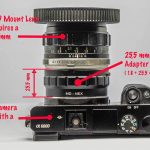
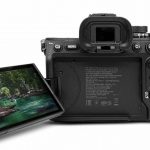
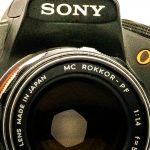


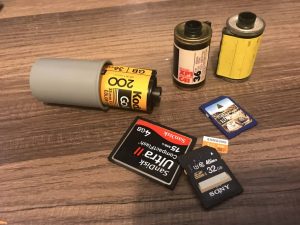
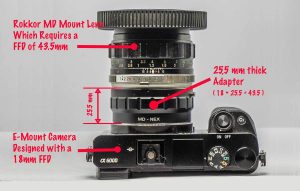

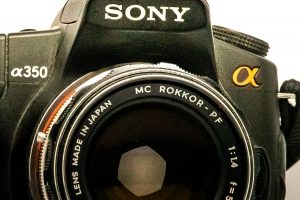

like a wirgin!
Dear Alphatracks ;D. You cannot really put a firm and clear line between consumer/ prosumer / professional -cameras. Image quality is ofcourse NOT the only factor that is of any relevance. A lot of crappy images have been shot by “professionals” (people that take pictures for a living). It depends on what kind of photography you’re talking about. A wildlife photographer has very different demands for his pictures AND his camera than a studio photographer that takes pictures for glossy magazines. The first wants a very sturdy, waterresistant, reliable and quiet camera..(a pop-up flash is therefore completely out of the question) and needs the images quality to be very good as well….the second primarely wants his pictures to be very very very sharp and does’nt mind a pull-up flash and LCD menus in his safe studio environment. To me the key-rule is “can the camera withstand everyday intensive use without constantly malfunctioning?”. A few things that make or break this reliability are:
1. hardware-knobs/selectors and buttons instead of (or as a redundant add on to) menus on an LCD (= very sensitive to falling/breaking and malfunctions under extreme temperatures)..
2. other manually operable features like flash/focussing/zooming instead of completely relying on little sensitive servo’s and stuff like that.
3. Support of tons of periferal hardware (connectivity and actual connectors on the body) like flashes, slave units, batterypacks and so on. Consumers-cameras mostly have a very short “life-span” (are quickly replaced by the next model that has poor or NO backwards compatibility) and are very poorly supported with Add ons/ options/ periferals.
I think the A100 more a “pro-sumer-camera” because it does have a pretty solid design and the reliable hardware knobs/selectors, but lacks a vertical grip / batterypack and has a ‘pull-up flash’.
Not so long ago I came your website and have been reading along steadily. I decided I might leave my first comment. I dont know exactly what to say except that I have really enjoyed reading. Cool blog. I intend to carry on coming back to this blog now and again. I have also subscribed to your feed to get any updates.